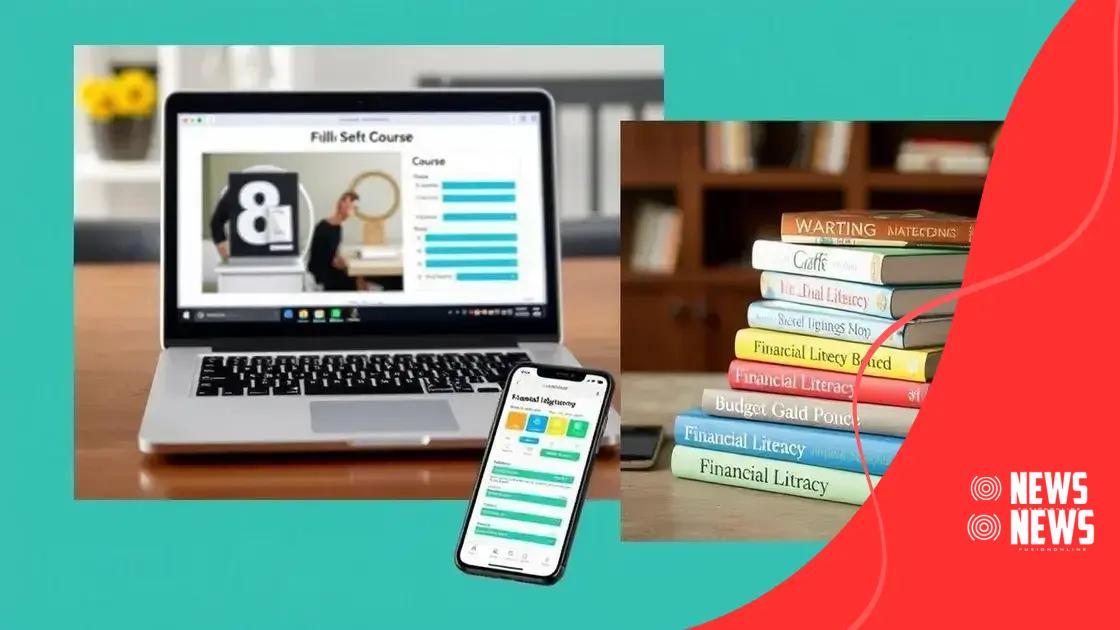Financial literacy: empowering the next generation

Financial literacy: empowering the next generation involves teaching essential money management skills, enabling students to make informed decisions about budgeting, saving, and investing for a secure financial future.
Financial literacy: empowering the next generation is more vital than ever in today’s fast-paced world. Have you ever wondered how well young people grasp financial concepts?
Understanding financial literacy and its importance
Understanding financial literacy is the foundation for making informed decisions about money. It helps individuals manage their finances effectively, leading to better financial well-being. Young people today face many financial choices, making it essential to grasp key concepts.
Financial literacy involves knowledge about budgeting, saving, and investing. Teaching these skills can be a game-changer. In schools, it’s crucial to include financial education in the curriculum. Students must learn the value of money early on and how to handle it wisely.
Key Components of Financial Literacy
There are several core areas of financial literacy:
- Budgeting: Knowing how to track income and expenses.
- Saving: Understanding the importance of saving for emergencies and future goals.
- Investing: Learning how to grow wealth over time through investments.
- Debt Management: Recognizing when and how to use credit responsibly.
Mastering these components can empower young people. It allows them to make choices that align with their goals. By understanding how money works, they can avoid common pitfalls.
In addition to school programs, parents can play a vital role in teaching financial literacy. Family discussions around finances can help children see real-life applications of what they learn. Engaging in conversations about spending and saving can foster a deeper understanding of these concepts.
Overall, enhancing financial literacy is more than just learning terms; it’s about creating a mindset geared towards financial success. By prioritizing financial education, we are setting up the next generation for success.
Key skills for financial empowerment
Key skills for financial empowerment play a crucial role in guiding individuals toward financial independence. Learning these skills can change lives and set a strong foundation for future success.
One essential skill is budgeting. Knowing how to create a budget allows individuals to manage their money well. It helps track spending, savings, and financial goals. By knowing where money goes, one can make better financial decisions.
Essential Skills for Financial Empowerment
Here are some vital skills that everyone should develop:
- Saving: Building a habit of saving is key. Start small and gradually increase savings.
- Investing: Understanding the basics of investing can help grow wealth over time. It’s important to learn about different investment options.
- Debt Management: Knowing how to manage and reduce debt is essential. This includes understanding credit scores and how to use credit wisely.
- Financial Goal Setting: Setting clear financial goals provides direction. It can motivate individuals to reach their targets.
Life skills, such as resilience and adaptability, also contribute to financial empowerment. Resilience helps in overcoming financial difficulties. Adaptability enables individuals to adjust their strategies as circumstances change. These soft skills, combined with financial knowledge, create a robust toolkit.
In today’s world, it is also important to be tech-savvy. Many financial tools and apps can assist in managing finances. Learning to use these resources effectively can enhance one’s ability to track expenses and savings.
Finally, continuous learning is vital. Financial literacy is not a one-time lesson but an ongoing journey. Engaging in workshops, reading books, and staying informed about financial news can help individuals remain knowledgeable and empowered.
Tools and resources for learning

There are many tools and resources available to enhance financial literacy. These resources help individuals build their knowledge and skills in managing money effectively. By utilizing these, learners can set themselves up for a successful financial future.
Online courses are a great starting point. Websites like Coursera, Khan Academy, and Udemy offer a variety of financial education courses. These platforms provide flexible learning options, making it easy to study at one’s own pace.
Free Financial Tools
In addition to courses, there are numerous free tools that can aid in financial learning:
- Budgeting Apps: Tools like Mint and YNAB (You Need a Budget) help track expenses and manage budgets effectively.
- Saving Calculators: Online calculators can show how savings can grow over time through interest.
- Investment Simulators: Platforms like Investopedia provide simulators for practice without risking real money.
- Financial Blogs and Podcasts: Following experts can provide valuable insights and tips.
These resources are engaging and can cater to different learning styles. For example, videos can simplify complex topics, while interactive tools reinforce learning through practice.
Community classes often provide an in-person option for those who prefer face-to-face learning. Local libraries and community centers frequently offer workshops on financial literacy topics, making it easy to access education for free or at a low cost.
Lastly, reading books about finance can deepen understanding. Titles like “The Total Money Makeover” or “Rich Dad Poor Dad” offer practical advice and perspectives for managing money wisely.
Incorporating financial literacy into education
Incorporating financial literacy into education is essential for preparing students for real-world financial challenges. Schools play a vital role in teaching young people the skills they need to manage their finances effectively.
One way to include financial literacy is through a structured curriculum. Educators can implement courses focusing on budgeting, saving, and investing. These subjects can provide students with a comprehensive understanding of how to manage money.
Effective Strategies for Teaching Financial Literacy
Here are some key strategies to enhance financial education:
- Integrate real-life scenarios: Using case studies and simulations can help students practice decision-making in financial scenarios.
- Utilize technology: Digital platforms and apps can make learning more interactive and engaging. Students can learn to budget using apps that track their expenses.
- Encourage discussions: Open discussions about money management can normalize conversations around finances. This helps reduce the stigma of talking about money.
- Collaborate with parents: Inviting parents to participate in financial education events can extend learning beyond the classroom. Family workshops can reinforce what students learn.
In addition, teachers can share personal finance stories to create relatable examples. When students see how adults handle their finances, they can learn valuable lessons. This approach can make financial concepts more understandable.
Moreover, after-school programs or clubs focused on financial literacy can encourage students to pursue their interests. These programs can offer projects that involve managing money, like running a small business or fundraising activities.
Finally, partnering with local businesses can provide students with insights into financial operations. Guest speakers from the finance industry can inspire students and show them practical applications of what they’re learning.
Inspiring stories of young financial wizards
Inspiring stories of young financial wizards highlight how individuals can achieve financial success from an early age. These stories show the power of financial literacy and the impact it can have on life decisions.
Many young people around the world have found innovative ways to manage their money. Take, for example, a teenager who started a small business selling handmade crafts. By understanding the importance of budgeting and reinvesting profits, this young entrepreneur has turned her hobby into a successful venture.
Real-Life Examples of Young Financial Wizards
Here are a few remarkable examples:
- Asset Builders: Some young people create savings accounts or invest in stocks. They often start with small amounts but grow their wealth over time.
- Peer Educators: Young adults who take the initiative to teach their friends about money management. They hold workshops and share resources to promote financial literacy.
- Innovative Fundraisers: Youths who design unique fundraising campaigns, such as bake sales or community events, demonstrate how to earn money while giving back.
- Budget Savvy Teens: Many high school students excel in managing their daily expenses through careful budgeting. They prioritize needs vs. wants and save for future goals.
These stories remind us that financial empowerment can come in many forms. Students often learn from each other through shared experiences. They exchange tips on saving, budgeting, and investing, creating a supportive community focused on financial growth.
Additionally, organizations and clubs that promote entrepreneurship offer young people mentorship and guidance. Programs encourage students to explore their interests while developing essential financial skills.
As these inspiring stories spread, they motivate others to take control of their finances. The journey of these young financial wizards reveals that with the right knowledge and determination, anyone can be a master of their financial future.
FAQ – Frequently Asked Questions about Financial Literacy Education
Why is financial literacy important for students?
Financial literacy equips students with essential money management skills, helping them make informed decisions about budgeting, saving, and investing.
How can schools incorporate financial literacy into their curriculum?
Schools can integrate financial literacy by offering dedicated courses, using online resources, and engaging students in interactive learning experiences.
What are some effective tools for teaching financial literacy?
Effective tools include budgeting apps, online courses, financial games, and community workshops that make learning engaging and practical.
Can parents help their children with financial literacy?
Yes, parents can support their children’s financial education by discussing money management at home, encouraging savings, and participating in educational events.





